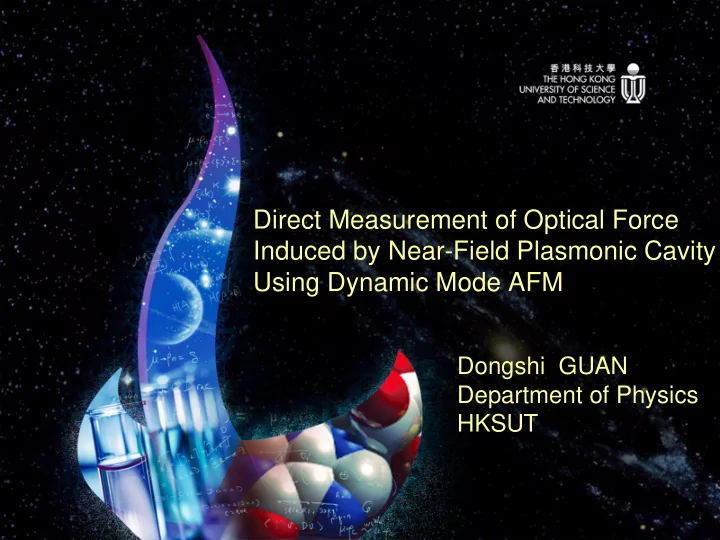

Direct Measurement of Optical Force Induced by Near-Field Plasmonic Cavity Using Dynamic Mode AFM Dongshi GUAN Department of Physics HKSUT
Direct Measurement of Optical Force Induced by Near- Field Plasmonic Cavity Using Dynamic Mode AFM Project leaders: Penger Tong C. T. Chan H. B. Chan Theory and simulation: Zhi Hong Hang Hui Liu Nano device fabrication: Zsolt Marcet I.I. Kravchenko This work was supported by Grant No. AoE/P-02/12. No. HKUST 605013.
Outline • Introduction • Experiment • Results • Conclusion Guan, D. et al. Sci. Rep. 5 , 16216 (2015).
Introduction Photon momentum Optical force How to enhance optical force ? (a) Focus: use a lens = = h λ p k / ∆ p I = = F A ∆ t c Plasmonic cavity and resonator (b) Resonance: use a cavity d r Liu, H. et.al., PRL. 106 , ~λ/2 087401 (2011). Marcet, Z. et al. PRL. 112 , 045504 (2014). Fabry perot resonator
Experiment Designed optical cavity with AFM d 200 nm Thickness gold 16 nm 250~750 nm quartz 200 nm Magnified top view of gold disks array nano structures λ =1550 nm Gold coated glass sphere 28.4 µ m in diameter on the end of a cantilever
Dynamic mode AFM = ω + ϕ ( ) cos( ' ) z t A t ( ) 2 = ω − ω + ω ξ 2 2 2 Force: ' ( ' / ) F Am m 0 0 The power spectrum density (PSD): πδ ω − ω + ξ 2 2 ' 2 F / m 2 ( ) 2 k T / m ω 2 = 0 B z ( ) ( ) ( ) 2 ω − ω + ωξ 2 2 2 / m 0 ω ’ 1 mW ξ r m ω k = ( ) , , 0 m measured form Force sensitivity: AC ~ 0.1 pN PSD fitting. = DC > 10 pN F kz 0
Results approaching receding Important variables: disk size d ( 250~750 nm) • the cavity separation r • λ =1550 nm Measured displacement amplitude A and phase delay ϕ .
Results Far-field ( r >3 μ m) amplitude and optical transmission λ =635 nm T ( d ) λ =1550 nm A ~ F ~ Intensity ~ Transmission T d ( ) 0 Normalized displacement amplitude: A(d) A / Excitation of the plasmonic 0 dipole mode of the gold disks. A(d): measured amplitude of pattern with disks diameter d A : measured amplitude of quartz substrate without patt e rn 0 Guan, D. et al. Sci. Rep. 5 , 16216 (2015).
Results Far-field ( r >3 μ m) phase delay and thermal effect Reduce thermal effects: Heat generated from the bottom, a. minimum power 1 mW transfers by thermal diffusion, b. reflective layer on cantilever beam is absorbed by the cantilever beam, c. driving frequency 55 kHz makes the uneven bending. Thermal effects do there !
Results Far-field ( r >3 μ m) phase delay and thermal effect (d) (d) Extra thermal force F T with phase delay φ T . φ T ≈ ω τ 0, τ 0 is the thermal diffusion time in air. F o (d) ~ Transmission T(d) α =( F T /F o )T(d)=0.17 F o ≈ F Guan, D. et al. Sci. Rep. 5 , 16216 (2015).
Results Near-field ( r <0.5 μ m) optical force enhancement ( ) 2 = ω − ω + ω ξ 2 2 2 Force: F Am ' ( ' / m ) 0 0 F’=F o T ( 625 ) /T ( d ) Optimized resonance Enhancement factor E under the experimental resonant conditions with λ =1550 nm, d =567 nm and r =30 nm is E =18.
Conclusion • Develop a sensitive dynamic mode AFM Force: pN, Size: nm, versatile. • Construct nano pattern plasmonic resonant cavity a. The gold dots diameter d~1/2 λ ; b. The cavity separation r . • Enhanced optical force in near filed Enhancement factor ~18. Guan, D. et al. Sci. Rep. 5 , 16216 (2015). • Thermal effect is unavoidable
Recommend
More recommend